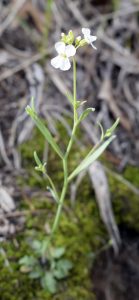Lyre-leaved Rock Cress
 Arabidopsis lyrata is a biennial plant, which means it takes 2 years to complete its life cycle. During the first year, the roots produce a very distinctive basal (low growing) rosette of leaves that are covered with stiff hairs, widely lobed at the tip with smaller side lobes. This lobed quality of the basal leaves resembles a lyre, and is where the Latin species name comes from. The basal leaves develop close to the ground and overwinter this way. In the 2nd year, a long (up to 15″) stem shoots up, hairless the higher it grows, with slender leaves and 4 tiny, rounded flower petals with 6 yellow stamens.
Arabidopsis lyrata is a biennial plant, which means it takes 2 years to complete its life cycle. During the first year, the roots produce a very distinctive basal (low growing) rosette of leaves that are covered with stiff hairs, widely lobed at the tip with smaller side lobes. This lobed quality of the basal leaves resembles a lyre, and is where the Latin species name comes from. The basal leaves develop close to the ground and overwinter this way. In the 2nd year, a long (up to 15″) stem shoots up, hairless the higher it grows, with slender leaves and 4 tiny, rounded flower petals with 6 yellow stamens.
Native to Minnesota, lyre-leaved rock cress is in the Brassicaceae (Mustard) family. The fruit forms as a 1″ long slender pod flattening as it ripens, thus completing the two-year life cycle. Bloom season extends April into August, giving rock cress plenty of time to set seeds for another biennial growth cycle.
As its name implies, rock cress’s delicate clusters of dainty white flowers can seemingly grow out of rocks along cliff faces. Dry, sandy soil suits this plant, and it enjoys both the dappled shade along wooded roadsides and trails as well as the full sun of sand dune and prairie habitats.
Happening upon a merry band of rock cress someday, you may just end up ambushed for a moment to stop and admire before continuing on your day’s sojourn.
